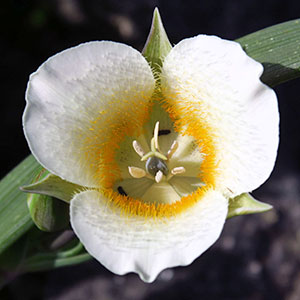Calochortus clavatus
Calochortus subalpinus
club hair mariposa, clubhair mariposa lily, slender mariposa lily
Cascade mariposa lily, cat's ear lily, mountain cat's ear, mountain mariposa, subalpine mariposa-lily
slender or coarse, stout, branching or not, strongly flexuous, 3–10 dm.
usually not branching, straight or flexuous, often scapelike, 0.5–3 dm.
basal withering, 1–2 dm;
blade linear.
basal 1–3 dm × 2–15 mm, usually equaling or exceeding stem length;
blade flat, adaxial surface glabrous.
subumbellate, 1–6-flowered;
bracts 4–8 cm, bases dilated.
subumbellate, 1–5-flowered;
bracts 2–several, lanceolate to linear, unequal, 1–5 cm, apex acuminate;
peduncle slender, becoming stouter, deflexed in fruit.
erect;
perianth open, cup-shaped;
sepals usually with red-brown blotch at base, lanceolate-ovate, 2–4 cm, apex acute;
petals lemon to golden yellow, with transverse line distal to gland, broadly cuneate to obovate, 3–5 cm;
glands round, deeply depressed, densely covered with short hairs with branching, coralline tips, surrounded by conspicuously fringed membrane and club-shaped hairs;
filaments ca. 10 mm;
anthers purplish brown, oblong, 4–10 mm.
erect or spreading;
perianth open, campanulate;
sepals typically with purple glandular blotch near base, oblong-lanceolate, shorter than petals, adaxial surface minutely hairy, apex acute to acuminate;
petals yellowish white, sometimes lavender-tinged, frequently with narrow purple crescent distal to gland, broadly obovate, cuneate, moderately bearded nearly to apex, adaxial surface densely hairy, margins fringed, apex obtuse or acute;
glands transversely oblong, arched upward, ± deeply depressed, bordered proximally by narrow, ascending, deeply fringed membrane, distally by narrow, crenate membranes, gland surface with rather long, slender hairs toward distal portion;
anthers lanceolate, apex long-apiculate.
erect, lanceoloid-linear, angled, 6–9 cm, apex acuminate.
nodding, 3-winged, ellipsoid, apex usually acute.
light yellow, translucent, flat.
pale yellow.
= 16.
= 20.
Calochortus clavatus
Calochortus subalpinus
Varieties 5 (5 in the flora).
(Discussion copyrighted by Flora of North America; reprinted with permission.)
1. Petals shorter than sepals; petal glands very deeply depressed. | var. avius |
1. Petals longer than sepals; petal glands shallowly to moderately depressed. | → 2 |
2. Stems straight, slender, usually 3 dm or shorter. | → 2 |
2. Stems flexuous, coarse, usually 5–10 dm. | → 3 |
3. Petals 3–4 cm, sparsely bearded; leaves not recurved. | var. gracilis |
3. Petals 4–5 cm, bearded; leaves strongly recurved. | var. recurvifolius |
4. Petals deep yellow, hairs very knobby; anthers deep purple. | var. clavatus |
4. Petals light yellow, hairs not very knobby; anthers yellow to medium purple. | var. pallidus |


